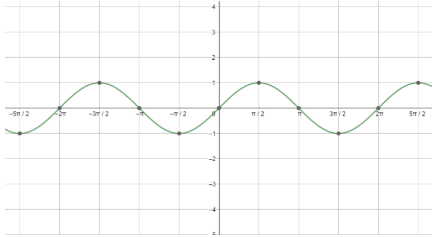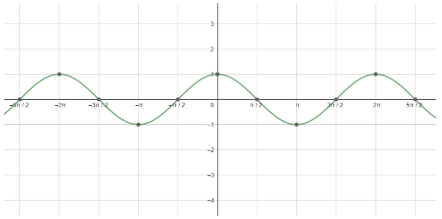Answer
414.9k+ views
Hint: Use the property that $\cos \left( 2\pi -x \right)=\cos x\text{ and cos}\left( \pi -x \right)=-\cos x$. Finally, put the values of $\cos 36{}^\circ \text{ and cos72}{}^\circ $.
Complete step-by-step answer:
Before moving to the solution, let us discuss the periodicity of sine and cosine function, which we would be using in the solution. All the trigonometric ratios, including sine and cosine, are periodic functions. We can better understand this using the graph of sine and cosine.
First, let us start with the graph of sinx.

Next, let us see the graph of cosx.

Looking at both the graphs, we can say that the graphs are repeating after a fixed period i.e. $2{{\pi }^{c}}$ . So, we can say that the fundamental period of the cosine function and the sine function is $2{{\pi }^{c}}=360{}^\circ $
We will now solve the equation given in the question.
$\cos \dfrac{\pi }{5}\cos \dfrac{2\pi }{5}\cos \dfrac{4\pi }{5}\cos \dfrac{8\pi }{5}$
$=\cos \dfrac{\pi }{5}\cos \dfrac{2\pi }{5}\cos \left( \pi -\dfrac{\pi }{5} \right)\cos \left( 2\pi -\dfrac{2\pi }{5} \right)$
Now we know $\cos \left( 2\pi -x \right)=\cos x\text{ and cos}\left( \pi -x \right)=-\cos x$ . On putting these values in our expression, we get
$=-\cos \dfrac{\pi }{5}\cos \dfrac{2\pi }{5}\cos \dfrac{\pi }{5}\cos \dfrac{2\pi }{5}$
$=-{{\cos }^{2}}\dfrac{\pi }{5}{{\cos }^{2}}\dfrac{2\pi }{5}$
Now we know that $\cos \dfrac{2\pi }{5}=\dfrac{\sqrt{3}-1}{2\sqrt{2}}\text{ and
cos}\dfrac{\pi }{5}=\dfrac{\sqrt{3}+1}{2\sqrt{2}}$ . On putting the values in our expression,
we get
$=-{{\left( \dfrac{\sqrt{3}-1}{2\sqrt{2}}\text{ }\times \dfrac{\sqrt{3}+1}{2\sqrt{2}}
\right)}^{2}}$
Now we will use the formula $\left( a+b \right)\left( a-b \right)={{a}^{2}}-{{b}^{2}}$ .
$=-{{\left( \dfrac{{{\left( \sqrt{3} \right)}^{2}}-{{\left( 1 \right)}^{2}}}{8} \right)}^{2}}$
$=-{{\left( \dfrac{3-1}{8} \right)}^{2}}$
$=-{{\left( \dfrac{2}{8} \right)}^{2}}$
$=-\dfrac{1}{16}$
Therefore, the answer to the expression in the above question is option (c) $\dfrac{-1}{16}$ .
Note: It is useful to remember the graph of the trigonometric ratios along with the signs of their values in different quadrants. For example: sine is always positive in the first and the second quadrant while negative in the other two. Also, remember the property of complementary angles of trigonometric ratios along with the values of trigonometric ratios of standard angles.
Complete step-by-step answer:
Before moving to the solution, let us discuss the periodicity of sine and cosine function, which we would be using in the solution. All the trigonometric ratios, including sine and cosine, are periodic functions. We can better understand this using the graph of sine and cosine.
First, let us start with the graph of sinx.

Next, let us see the graph of cosx.

Looking at both the graphs, we can say that the graphs are repeating after a fixed period i.e. $2{{\pi }^{c}}$ . So, we can say that the fundamental period of the cosine function and the sine function is $2{{\pi }^{c}}=360{}^\circ $
We will now solve the equation given in the question.
$\cos \dfrac{\pi }{5}\cos \dfrac{2\pi }{5}\cos \dfrac{4\pi }{5}\cos \dfrac{8\pi }{5}$
$=\cos \dfrac{\pi }{5}\cos \dfrac{2\pi }{5}\cos \left( \pi -\dfrac{\pi }{5} \right)\cos \left( 2\pi -\dfrac{2\pi }{5} \right)$
Now we know $\cos \left( 2\pi -x \right)=\cos x\text{ and cos}\left( \pi -x \right)=-\cos x$ . On putting these values in our expression, we get
$=-\cos \dfrac{\pi }{5}\cos \dfrac{2\pi }{5}\cos \dfrac{\pi }{5}\cos \dfrac{2\pi }{5}$
$=-{{\cos }^{2}}\dfrac{\pi }{5}{{\cos }^{2}}\dfrac{2\pi }{5}$
Now we know that $\cos \dfrac{2\pi }{5}=\dfrac{\sqrt{3}-1}{2\sqrt{2}}\text{ and
cos}\dfrac{\pi }{5}=\dfrac{\sqrt{3}+1}{2\sqrt{2}}$ . On putting the values in our expression,
we get
$=-{{\left( \dfrac{\sqrt{3}-1}{2\sqrt{2}}\text{ }\times \dfrac{\sqrt{3}+1}{2\sqrt{2}}
\right)}^{2}}$
Now we will use the formula $\left( a+b \right)\left( a-b \right)={{a}^{2}}-{{b}^{2}}$ .
$=-{{\left( \dfrac{{{\left( \sqrt{3} \right)}^{2}}-{{\left( 1 \right)}^{2}}}{8} \right)}^{2}}$
$=-{{\left( \dfrac{3-1}{8} \right)}^{2}}$
$=-{{\left( \dfrac{2}{8} \right)}^{2}}$
$=-\dfrac{1}{16}$
Therefore, the answer to the expression in the above question is option (c) $\dfrac{-1}{16}$ .
Note: It is useful to remember the graph of the trigonometric ratios along with the signs of their values in different quadrants. For example: sine is always positive in the first and the second quadrant while negative in the other two. Also, remember the property of complementary angles of trigonometric ratios along with the values of trigonometric ratios of standard angles.
Recently Updated Pages
Three beakers labelled as A B and C each containing 25 mL of water were taken A small amount of NaOH anhydrous CuSO4 and NaCl were added to the beakers A B and C respectively It was observed that there was an increase in the temperature of the solutions contained in beakers A and B whereas in case of beaker C the temperature of the solution falls Which one of the following statements isarecorrect i In beakers A and B exothermic process has occurred ii In beakers A and B endothermic process has occurred iii In beaker C exothermic process has occurred iv In beaker C endothermic process has occurred

The branch of science which deals with nature and natural class 10 physics CBSE

The Equation xxx + 2 is Satisfied when x is Equal to Class 10 Maths

Define absolute refractive index of a medium

Find out what do the algal bloom and redtides sign class 10 biology CBSE

Prove that the function fleft x right xn is continuous class 12 maths CBSE

Trending doubts
Difference between Prokaryotic cell and Eukaryotic class 11 biology CBSE

Difference Between Plant Cell and Animal Cell

Select the word that is correctly spelled a Twelveth class 10 english CBSE

Fill the blanks with the suitable prepositions 1 The class 9 english CBSE

What is the z value for a 90 95 and 99 percent confidence class 11 maths CBSE

Give 10 examples for herbs , shrubs , climbers , creepers

What organs are located on the left side of your body class 11 biology CBSE

What is BLO What is the full form of BLO class 8 social science CBSE

Change the following sentences into negative and interrogative class 10 english CBSE



